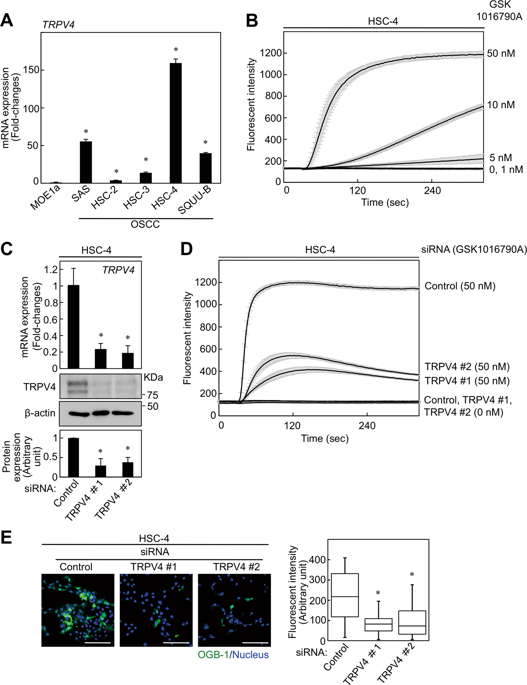当前位置:
X-MOL 学术
›
Lab. Invest.
›
论文详情
Our official English website, www.x-mol.net, welcomes your
feedback! (Note: you will need to create a separate account there.)
The TRPV4-AKT axis promotes oral squamous cell carcinoma cell proliferation via CaMKII activation.
Laboratory Investigation ( IF 5.1 ) Pub Date : 2019-12-19 , DOI: 10.1038/s41374-019-0357-z Shinsuke Fujii 1 , Yudai Tajiri 1, 2 , Kana Hasegawa 1 , Shinji Matsumoto 3 , Reiko U Yoshimoto 1, 4, 5 , Hiroko Wada 1 , Shosei Kishida 6 , Mizuho A Kido 4 , Hiromasa Yoshikawa 2 , Satoru Ozeki 2 , Tamotsu Kiyoshima 1
Laboratory Investigation ( IF 5.1 ) Pub Date : 2019-12-19 , DOI: 10.1038/s41374-019-0357-z Shinsuke Fujii 1 , Yudai Tajiri 1, 2 , Kana Hasegawa 1 , Shinji Matsumoto 3 , Reiko U Yoshimoto 1, 4, 5 , Hiroko Wada 1 , Shosei Kishida 6 , Mizuho A Kido 4 , Hiromasa Yoshikawa 2 , Satoru Ozeki 2 , Tamotsu Kiyoshima 1
Affiliation

|
Most human malignant tumor cells arise from epithelial tissues, which show distinctive characteristics, such as polarization, cell-to-cell contact between neighboring cells, and anchoring to a basement membrane. When tumor cells invaginate into the stroma, the cells are exposed to extracellular environments, including the extracellular matrix (ECM). Increased ECM stiffness has been reported to promote cellular biological activities, such as excessive cellular growth and enhanced migration capability. Therefore, tumorous ECM stiffness is not only an important clinical tumor feature but also plays a pivotal role in tumor cell behavior. Transient receptor potential vanilloid 4 (TRPV4), a Ca2+-permeable nonselective cation channel, has been reported to be mechano-sensitive and to regulate tumorigenesis, but the underlying molecular mechanism in tumorigenesis remains unclear. The function of TRPV4 in oral squamous cell carcinoma (OSCC) is also unknown. The current study was conducted to investigate whether or not TRPV4 might be involved in OSCC tumorigenesis. TRPV4 mRNA levels were elevated in OSCC cell lines compared with normal oral epithelial cells, and its expression was required for TRPV4 agonist-dependent Ca2+ entry. TRPV4-depleted tumor cells exhibited decreased proliferation capabilities in three-dimensional culture but not in a low-attachment plastic dish. A xenograft tumor model demonstrated that TRPV4 expression was involved in cancer cell proliferation in vivo. Furthermore, loss-of-function experiments using siRNA or an inhibitor revealed that the TRPV4 expression was required for CaMKII-mediated AKT activation. Immunohistochemical analyses of tissue specimens obtained from 36 OSCC patients showed that TRPV4 was weakly observed in non-tumor regions but was strongly expressed in tumor lesions at high frequencies where phosphorylated AKT expression was frequently detected. These results suggest that the TRPV4/CaMKII/AKT axis, which might be activated by extracellular environments, promotes OSCC tumor cell growth.
中文翻译:

TRPV4-AKT 轴通过 CaMKII 激活促进口腔鳞状细胞癌细胞增殖。
大多数人类恶性肿瘤细胞起源于上皮组织,这些组织表现出独特的特征,例如极化、相邻细胞之间的细胞间接触以及锚定在基底膜上。当肿瘤细胞侵入基质时,细胞会暴露于细胞外环境,包括细胞外基质 (ECM)。据报道,ECM 刚度增加可促进细胞生物活动,例如细胞过度生长和迁移能力增强。因此,肿瘤细胞外基质硬度不仅是重要的临床肿瘤特征,而且在肿瘤细胞行为中起着举足轻重的作用。据报道,瞬时受体电位香草酸 4 (TRPV4) 是一种可渗透 Ca2+ 的非选择性阳离子通道,对机械敏感并可调节肿瘤发生,但肿瘤发生的潜在分子机制仍不清楚。TRPV4 在口腔鳞状细胞癌 (OSCC) 中的功能也未知。目前的研究旨在调查 TRPV4 是否可能参与 OSCC 肿瘤发生。与正常口腔上皮细胞相比,OSCC 细胞系中 TRPV4 mRNA 水平升高,其表达是 TRPV4 激动剂依赖性 Ca2+ 进入所必需的。TRPV4 耗尽的肿瘤细胞在三维培养中表现出增殖能力下降,但在低附着塑料培养皿中则没有。异种移植肿瘤模型证明 TRPV4 表达参与体内癌细胞增殖。此外,使用 siRNA 或抑制剂的功能丧失实验表明,TRPV4 表达是 CaMKII 介导的 AKT 激活所必需的。对从 36 例 OSCC 患者获得的组织标本进行的免疫组织化学分析表明,TRPV4 在非肿瘤区域微弱地观察到,但在经常检测到磷酸化 AKT 表达的高频肿瘤病变中强烈表达。这些结果表明,可能被细胞外环境激活的 TRPV4/CaMKII/AKT 轴促进了 OSCC 肿瘤细胞的生长。
更新日期:2019-12-20
中文翻译:

TRPV4-AKT 轴通过 CaMKII 激活促进口腔鳞状细胞癌细胞增殖。
大多数人类恶性肿瘤细胞起源于上皮组织,这些组织表现出独特的特征,例如极化、相邻细胞之间的细胞间接触以及锚定在基底膜上。当肿瘤细胞侵入基质时,细胞会暴露于细胞外环境,包括细胞外基质 (ECM)。据报道,ECM 刚度增加可促进细胞生物活动,例如细胞过度生长和迁移能力增强。因此,肿瘤细胞外基质硬度不仅是重要的临床肿瘤特征,而且在肿瘤细胞行为中起着举足轻重的作用。据报道,瞬时受体电位香草酸 4 (TRPV4) 是一种可渗透 Ca2+ 的非选择性阳离子通道,对机械敏感并可调节肿瘤发生,但肿瘤发生的潜在分子机制仍不清楚。TRPV4 在口腔鳞状细胞癌 (OSCC) 中的功能也未知。目前的研究旨在调查 TRPV4 是否可能参与 OSCC 肿瘤发生。与正常口腔上皮细胞相比,OSCC 细胞系中 TRPV4 mRNA 水平升高,其表达是 TRPV4 激动剂依赖性 Ca2+ 进入所必需的。TRPV4 耗尽的肿瘤细胞在三维培养中表现出增殖能力下降,但在低附着塑料培养皿中则没有。异种移植肿瘤模型证明 TRPV4 表达参与体内癌细胞增殖。此外,使用 siRNA 或抑制剂的功能丧失实验表明,TRPV4 表达是 CaMKII 介导的 AKT 激活所必需的。对从 36 例 OSCC 患者获得的组织标本进行的免疫组织化学分析表明,TRPV4 在非肿瘤区域微弱地观察到,但在经常检测到磷酸化 AKT 表达的高频肿瘤病变中强烈表达。这些结果表明,可能被细胞外环境激活的 TRPV4/CaMKII/AKT 轴促进了 OSCC 肿瘤细胞的生长。











































 京公网安备 11010802027423号
京公网安备 11010802027423号